
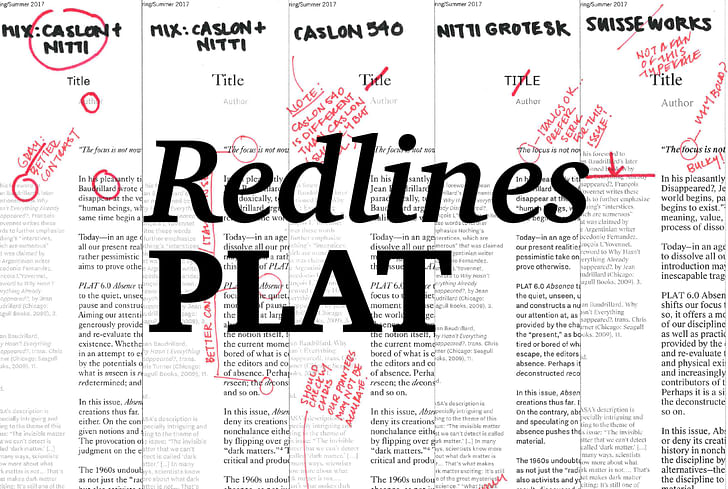
Redlines is a collection of interviews with editors that make today's most provocative architectural publications come to life. While architecture is traditionally concerned with buildings, materials, and scale, their importance and historical impact are recorded through words, books, and images that are often organized, published, and disseminated. Redlines seeks to understand the pedagogical and design frameworks that shape this process.
In this session, we look at PLAT, a journal run entirely by the students of the Rice School of Architecture.
What is the history of the publication?
PLAT was launched in 2010 with its inaugural issue 0.5 On the Ground by a group of graduate students at Rice University's School of Architecture. Its name comes from framing a territory—planning or devising a project—and since then the journal has evolved into an open and progressive dialogue between design, production, and theory. Today, we continue to “plat forth” with every issue.
Who runs the publication?
PLAT is run entirely by the students of the Rice School of Architecture, although its editors often solicit advice from faculty members. The editors serve for a period of one year, and are usually either in their final year of the B.Arch program or are M.Arch candidates.
How are the issues constructed?
Each issue explores a different theme through content ranging from interviews to essays to drawings which are contributed by practitioners, artists, designers, theorists, historians, thinkers, students, and faculty within or beyond our school.
PLAT’s structure also alternates between a full issue of “.0” and a half issue of “.5”. This structure permits the journal to be at once rigorous and loose. The “.0” issue presents a new topic, to which the following “.5” issue aims to respond. The alternation allows the journal to be in constant dialogue with itself, collecting criticism, review, and judgment regarding the material the previous issue has put on the table.
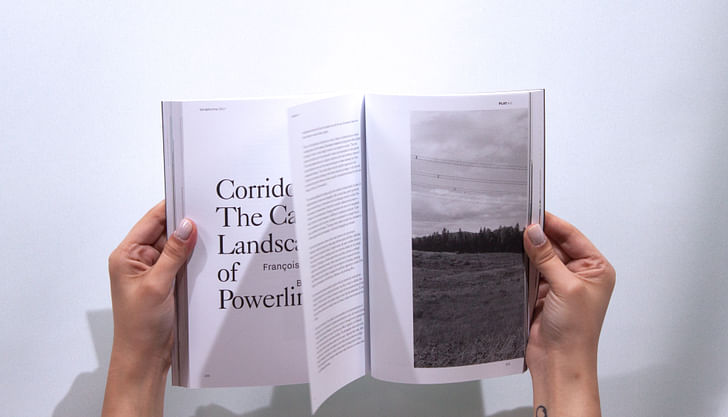
The theme of each issue is determined by the editorial team and announced through an open call. In addition to these submissions, editors may choose to solicit content. All of the selected pieces are then curated to span a variety of directions under the theme, while ultimately complementing one another in a cohesive whole.
Is there any other medium to it but the printed object?
Not at the moment. Given the speed of production, the anthology is more powerful in the printed form. Print media is not dead, right?
How often is it released?
PLAT is released at the least once every academic year and sometimes twice. We’ve had twelve issues in nine years.
What does it focus on?
PLAT is motivated by a desire to further discussions in the discipline of architecture, but beyond that its precise focus changes with each issue. Issues explore different themes which the editors have found worthy of further investigation and commentary. Past issues have delved into themes of Absence, License, Frequency, En Masse, and more.
How are the editors organized?
We have three main types of editors: Editor(s)-in-Chief, Managing Editor(s), and Graphic Editor(s). Each team has a different configuration and dynamic. The Editor-in-Chief drives content, while Graphics leads the look of the journal, and Managing Editor is a jack-of-all trades.
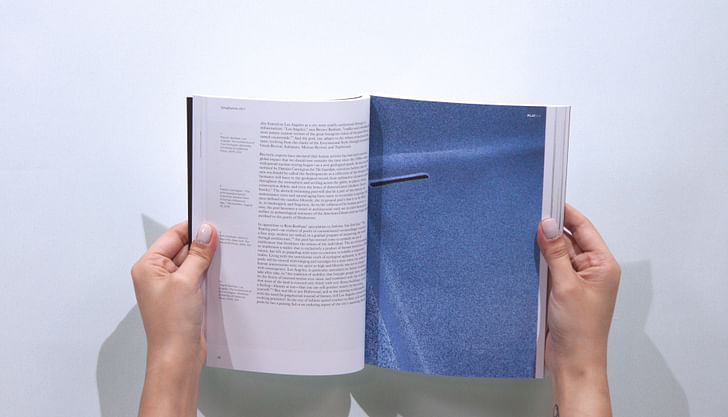
What is the long-term goal of the publication?
PLAT’s goals are to continue provoking and expanding the discussions we have within and around architecture. As students we notice certain tropes and fads, but we also are looking for answers as we learn what it is to be an architect, and PLAT gives us a platform to explore these avenues further, or uncover new directions.
What has been the most interesting issue in your eyes so far?
Truthfully, every issue has tapped into intriguing subjects worthy of discussion. PLAT 5.5 Re: License was especially interesting as it communicated a certain message through its format. Reviving the legacy of PLAT’s half-issue format through responding to the preceding issue 5.0 License, PLAT 5.5 Re: License was invigorated by the question “What does it mean to create discourse around and through a journal?” It presented a retrospective look on License and in curating this ‘response,’ the issue capitalized on conversation as a medium, which reflects the way Rice Architecture engages in architectural discourse. It also includes a thread between the editors and contributors of 5.0 License reflecting on the process of making that issue. This was an opportunity for contributors to communicate directly, often for the first time, and reflect on the entirety of the issue.
Defining conversation as an uncertain, unknown, and incomplete activity, PLAT 5.5 treats License as an open conversation and continues it through capturing reaction, review, and judgment. The past editors returned to share their reflections on the process of making their issue; the contributors of 5.0 critiqued their varied interpretations of license and contemplated on the common threads of their submissions; and current faculty, students, and visitors at Rice discussed the topic and its tangents, such as authorship, copyright, influence, fakes, etc. further.
What weaknesses does the publication have?
Perhaps not a weakness but a challenge the publication faces is that, due its nature of being student-run within the School of Architecture, the editorial team changes every year. This turn-over brings new energy and editorial perspective to each issue while, on the flip side, it means that every year the new team of editors goes through the same learning process. Therefore, it is important to us that the consecutive teams have open communication for passing along information and advice.
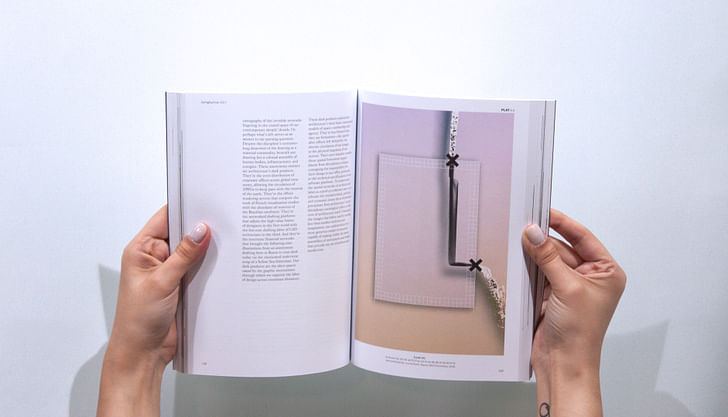
What is the role of publications today?
Publications are the driving forces of our disciplinary discourse—they simultaneously act as historians, mediators, and provocateurs. With every criticism delivered and every topic entertained, publications shape and guide our current conversations. Publications also hold the responsibility of engaging already begun topics, events, and discussions. They are platforms for generating new theories and criticisms, for exploring current tendencies, and for rethinking past debates.
How involved is the affiliated academic institution?
Even though the publication is entirely student-run—from the selection of themes to the appointment of editorial teams—the Rice School of Architecture ethos and its faculty greatly influence the content and direction of the publication. Our dean, Sarah Whiting, is especially influential in the making of the journal, not only by being a sounding board and writing the foreword to each issue, but also with the experience, advice, and support she shares with us each time.
Additionally, the values and methods of discourse practiced at Rice School of Architecture reflect themselves on the pages of PLAT. PLAT’s selection of topics and the form we choose to deliver them in parallels the current discussions and the way students, faculty, and guests at Rice engage with the discipline.
The Rice School of Architecture also funds a majority of the journal. We are so grateful for their support.
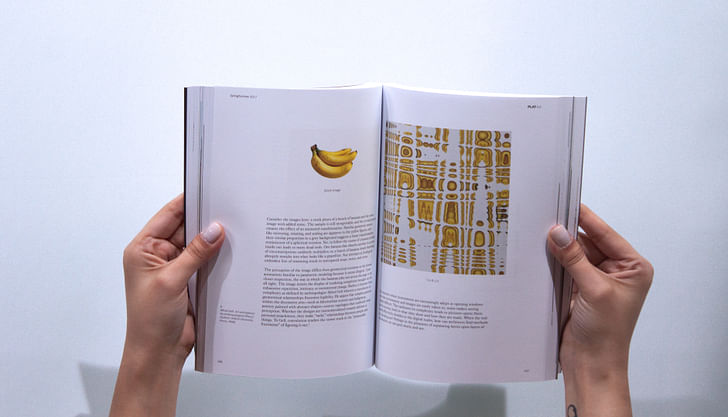
What is the most recent issue focused on?
The most recent issue, PLAT 6.0, focuses on the theme of “Absence.” The editors, Melis Ugurlu and Rachel Grady, were intrigued by the potentials of absence and desired to shift the discipline’s focus to the quiet, unseen, unnoticed, and rare. Therefore, PLAT 6.0 Absence constructs a nuanced reading of our discipline, aiming to offer a moment of pause from the age of spectacle and excess that we are in. The collection of work conveys the range of readings that arise from a word, arguing that, both semantically and derivatively, absence’s meaning is manifold. Whether it is through focusing on absence as a physical, social, psychological, economic, destructive, or uncertain entity, the contributions in this issue unwittingly weave together to showcase the superfluity of interpretation.
Tell us something someone would not know from turning the pages of the publication itself.
When the theme is decided on, the editors have a notion of where the journal will go, but each time we are wowed by how much broader the range of interpretations are. We intentionally select themes that open themselves up to variety, but what is written about reminds us why it is so important to showcase various voices through the expanse of our platform. This unpredictability is something we enjoy very much in the curation of an issue because the input from our contributors sheds new light on our understanding and ultimately makes the production of each publication truly collaborative. The process from initial conception to finished product is a journey filled with mysteries.
Anthony Morey is a Los Angeles based designer, curator, educator, and lecturer of experimental methods of art, design and architectural biases. Morey concentrates in the formulation and fostering of new modes of disciplinary engagement, public dissemination, and cultural cultivation. Morey is the ...
No Comments
Block this user
Are you sure you want to block this user and hide all related comments throughout the site?
Archinect
This is your first comment on Archinect. Your comment will be visible once approved.